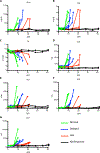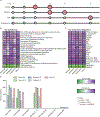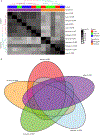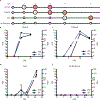A conserved transcriptional response to intranasal Ebola virus exposure in nonhuman primates prior to onset of fever
- PMID: 29593102
- PMCID: PMC9986849
- DOI: 10.1126/scitranslmed.aaq1016
A conserved transcriptional response to intranasal Ebola virus exposure in nonhuman primates prior to onset of fever
Abstract
Ebola virus disease (EVD), caused by Ebola virus (EBOV), is a severe illness characterized by case fatality rates of up to 90%. The sporadic nature of outbreaks in resource-limited areas has hindered the ability to characterize the pathogenesis of EVD at all stages of infection but particularly early host responses. Pathogenesis is often studied in nonhuman primate (NHP) models of disease that replicate major aspects of human EVD. Typically, NHP models use a large infectious dose, are carried out through intramuscular or aerosol exposure, and have a fairly uniform disease course. By contrast, we report our analysis of the host response to EBOV after intranasal exposure. Twelve cynomolgus macaques were infected with 100 plaque-forming units of EBOV/Makona through intranasal exposure and presented with varying times to onset of EVD. We used RNA sequencing and a newly developed NanoString CodeSet to monitor the host response via changes in RNA transcripts over time. When individual animal gene expression data were phased based on the onset of sustained fever, the first clinical sign of severe disease, mathematical models indicated that interferon-stimulated genes appeared as early as 4 days before fever onset. This demonstrates that lethal EVD has a uniform and predictable response to infection regardless of time to onset. Furthermore, expression of a subset of genes could predict disease development before other host-based indications of infection such as fever.
Copyright © 2018 The Authors, some rights reserved; exclusive licensee American Association for the Advancement of Science. No claim to original U.S. Government Works.
Conflict of interest statement
Figures








Similar articles
-
Comparison of Transcriptomic Platforms for Analysis of Whole Blood from Ebola-Infected Cynomolgus Macaques.Sci Rep. 2017 Nov 7;7(1):14756. doi: 10.1038/s41598-017-15145-7. Sci Rep. 2017. PMID: 29116224 Free PMC article.
-
Oral and Conjunctival Exposure of Nonhuman Primates to Low Doses of Ebola Makona Virus.J Infect Dis. 2016 Oct 15;214(suppl 3):S263-S267. doi: 10.1093/infdis/jiw149. Epub 2016 Jun 9. J Infect Dis. 2016. PMID: 27284090 Free PMC article.
-
Development of a Lethal Intranasal Exposure Model of Ebola Virus in the Cynomolgus Macaque.Viruses. 2017 Oct 29;9(11):319. doi: 10.3390/v9110319. Viruses. 2017. PMID: 29109373 Free PMC article.
-
Nonhuman Primate Models of Ebola Virus Disease.Curr Top Microbiol Immunol. 2017;411:171-193. doi: 10.1007/82_2017_20. Curr Top Microbiol Immunol. 2017. PMID: 28643203 Review.
-
The challenge of using experimental infectivity data in risk assessment for Ebola virus: why ecology may be important.J Appl Microbiol. 2016 Jan;120(1):17-28. doi: 10.1111/jam.12973. Epub 2015 Nov 26. J Appl Microbiol. 2016. PMID: 26480954 Review.
Cited by
-
Characterization of the plasma proteome of nonhuman primates during Ebola virus disease or melioidosis: a host response comparison.Clin Proteomics. 2019 Feb 7;16:7. doi: 10.1186/s12014-019-9227-3. eCollection 2019. Clin Proteomics. 2019. PMID: 30774579 Free PMC article.
-
Transcriptomic Analysis Reveals Host miRNAs Correlated with Immune Gene Dysregulation during Fatal Disease Progression in the Ebola Virus Cynomolgus Macaque Disease Model.Microorganisms. 2021 Mar 23;9(3):665. doi: 10.3390/microorganisms9030665. Microorganisms. 2021. PMID: 33806942 Free PMC article.
-
Transcriptome mining extends the host range of the Flaviviridae to non-bilaterians.Virus Evol. 2022 Dec 26;9(1):veac124. doi: 10.1093/ve/veac124. eCollection 2023. Virus Evol. 2022. PMID: 36694816 Free PMC article.
-
SITC cancer immunotherapy resource document: a compass in the land of biomarker discovery.J Immunother Cancer. 2020 Dec;8(2):e000705. doi: 10.1136/jitc-2020-000705. J Immunother Cancer. 2020. PMID: 33268350 Free PMC article.
-
Detecting Pathogen Exposure During the Non-symptomatic Incubation Period Using Physiological Data: Proof of Concept in Non-human Primates.Front Physiol. 2021 Sep 3;12:691074. doi: 10.3389/fphys.2021.691074. eCollection 2021. Front Physiol. 2021. PMID: 34552498 Free PMC article.
References
-
- Center for Disease Control (CDC), 2014. Ebola Outbreak in West Africa - Case Counts | Ebola Hemorrhagic Fever | CDC (available at https://www.cdc.gov/vhf/ebola/outbreaks/2014-west-africa/case-counts.html).
Publication types
MeSH terms
Grants and funding
LinkOut - more resources
Full Text Sources
Other Literature Sources
Medical
Molecular Biology Databases

